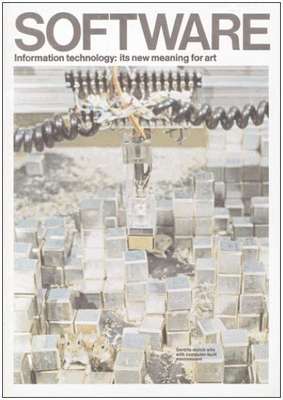This exhibition investigated relations between computer art and conceptual art emphasizing software as opposed to hardware.
Its aim was to “demonstrate the effects of contemporary control and communication techniques in the hands of artists” (cited after 258).
The term Software does not only refer to systems of programs and data, as it usually does in computer science. It implicitly calls for the difference between hardware and software, the machine to do something, and the description of what is to be done. Both rely upon each other. But their ontological states are radically different. In the context of this exhibition, the word Software is also used almost as a synonym for communication 258.
The exhibition tried to “focus esthetic sensibility on the fastest growing technology in our culture: the information processing systems” (cited after 259).
The computer (i.e. the hardware) as the machine to carry out certain operations that would eventually result in a visible or audible artifact and, thus, in the perceivable work that may become acknowledged as a work of art, had to step back in this show behind the description (software!) of the operations the computer would carry out. When software takes command, the making becomes less important than the description of the making. Showing and perceiving almost become by-products of describing how to make what is to be shown and perceived. This is the revolution brought into the arts by computing machinery. It is part of the algorithmic revolution. Was Software’s curator, Jack Burnham, aware of this? Most likely, he was.
In opposition to exhibitions like The Machine, as Seen at the End of the Mechanical Age Software was not about getting together artists and technologists, or to duplicate effects of traditional forms of art. It rather dealt with systems, processes, and concepts and, as Jack Burnham 227 states,
“it may not be, and probably is not, the province of computers and other telecommunication devices to produce art as we know it; but they will, in fact, be instrumental in redefining the entire area of esthetic awareness”(cited after 260)
Beginning with the opening, the exhibition was plagued with problems: A short circuited computer ruined some electronic gear during the opening night and didn’t work until one month after the start of the exhibition. A series of five films documenting discussion on “Software” where destroyed, and the museum was charged by two contributors for censoring their works.
Technical problems with the museum’s major computer (a PDP-8) became the source of rumours of sabotage.
The films where allegedly destroyed after “a dispute over unauthorized additions to the film of statements by Mao tse-Tung” 258. The remains of the films where exhibited nevertheless.
The charges in question where raised by two artists, Les Levine and John Giorno, who also threatened to withdraw their works from the exhibition.
Levine stated that the museum had edited “a little nudity” (eight minutes of sexual intercourse) out of one of his shown works 258.
Giorno supported Levine by criticizing the museum for not allowing him to broadcast taped writings of Eldridge Cleaver, the Black Panther Party leader, within one of his installations.
Burnham’s broad usage of the term software in opposition to the usual interpretation became the topic of a series of critiques in Leonardo (256, 261 and 262).
8258259260


